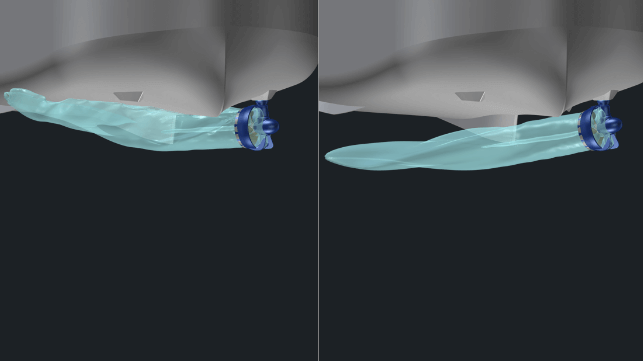External Experts Confirm High Propulsion Efficiency of the SCHOTTEL SRP-D

[By: SCHOTTEL]
The increased performance of the SCHOTTEL RudderPropeller Dynamic SRP-D has once again been confirmed by external sources. At the request of the Dutch Damen Group, the Maritime Research Institute Netherlands (MARIN) carried out extensive research to demonstrate the added value of the SRP-D for Commissioning Service Operation Vessels (CSOV). While an earlier study had already demonstrated a reduced DP footprint and fuel savings, Damen’s latest research focused particularly on propulsion efficiency during thruster interactions. The results obtained show a significant increase in thrust yield as well as reduced forbidden zones with the SRP-D compared to conventional rudder propellers.
“Our clients will have life-long benefits by selecting this combination”
“In our continuous strive for offering optimal vessels to our clients, SCHOTTEL’s developments are a great step”, says Mark Couwenberg, Product Portfolio Manager SOVs at Damen. “The SRP-D thrusters mounted under Damen’s optimized hulls result in vessels with a smaller footprint while at the same time reducing fuel use and further improving comfort on board. Combined with SCHOTTEL’s robust methods of design, engineering and construction we are convinced that our clients will have life-long benefits by selecting this combination.”
Higher positioning accuracy
With the SRP-D optimized for DP operation, SCHOTTEL is meeting the increased efficiency and reliability requirements for CSOV vessels. The thruster is marked by an additional eight-degree tilt of the lower gearbox and a vertically integrated electric drive motor (LE-Drive). In addition, the SRP-D is characterized by reduced propeller acceleration/deceleration times. In combination with a high-speed azimuth steering system with reinforced gear components, the SRP-D enables faster thrust allocation than conventional rudder propellers. Thanks to the shorter response times, it is possible to react faster and in a more targeted manner to external forces such as wind and currents, thus achieving a higher positional accuracy of the vessel.
Offshore basin as testing facility
The research was carried out on a model of a CSOV equipped with a SCHOTTEL SRP-D on starboard and a regular 90-degree thruster on portside. To perform the tests, the model was placed in a 45-metre-long and 36-metre-wide offshore basin. A three-component measurement frame with calibrated sensors was installed on the model for data acquisition.
98-degree tilted propeller shaft significantly reduces thrust losses
The first part of the study measured the interactions between propulsion unit and hull. It was found that the additional eight-degree downward tilt of the SRP-D propeller shaft could significantly reduce thrust losses, both for azimuth variations and thrust variations. For example, CSOVs with 98-degree thrusters experience only 10 percent thrust losses in transverse direction, compared to 35 percent with 90-degree thrusters. The study shows that a key factor for the improved system performance is a reduced Coand? effect with the SRP-D.
The second part of the research focuses on the propeller flow interactions. Again, significantly lower thrust losses occur when operating CSOVs with the SRP-D: While 50 percent losses are observed when the 90-degree thruster is blowing the wake into the second thruster (in-line thrust losses), only 20 percent thrust losses occur with the 98-degree thruster. When the 90-degree thruster is blowing the wake into the second one while being perpendicular to it (transverse thrust losses), the thrust in transverse direction is decreased by about 40 percent, compared to 20 percent with the 98-degree thruster. In both cases, the 98-degree variant thus induces lower losses at the other thruster than the 90-degree variant and therefore enables a higher remaining force during DP.
Fuel-efficient and safe operation throughout the year
As the research shows, the additional eight-degree tilt of the SRP-D gearbox significantly optimizes thrust yield and thrust distribution, since thruster-hull- and thruster-thruster-interactions are minimized. Consequently, the forbidden zones of the thrusters may be reduced, which leads to an additional increase of the DP performance for the vessel. Furthermore, CSOVs can significantly lower their fuel consumption. Overall, the vessels operate much more efficiently and safely, extending their operating time throughout the year.
The products and services herein described in this press release are not endorsed by The Maritime Executive.
